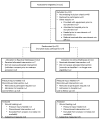Comparative Effectiveness of Active and Reactive Mattresses in Pressure Injury Healing for Older People in Their Own Homes: A Pragmatic Equivalence Randomised-Controlled Study
- PMID: 40137685
- PMCID: PMC11945283
- DOI: 10.3390/nursrep15030111
Comparative Effectiveness of Active and Reactive Mattresses in Pressure Injury Healing for Older People in Their Own Homes: A Pragmatic Equivalence Randomised-Controlled Study
Abstract
Background: Pressure injuries are an ongoing problem commonly managed with the prescription of pressure mattresses. There is conflicting research about the comparable effectiveness of the two types of pressure mattresses, active and reactive. This, coupled with technological advances and an updated understanding of pressure aetiology, means decision-making when prescribing pressure mattresses is complicated. Objective/Design: A pragmatic approach was used to design an equivalence randomised-controlled trial investigating the comparative effectiveness of active and reactive pressure mattresses in a community setting from a wound healing perspective as well as from a user acceptability perspective. Methods: Participants with an existing pressure injury were provided with an active or reactive mattress for wound healing, with wound stages assessed using photography. Usual clinical care was provided based on the protocols of the health care service, including nursing and occupational therapy input. Participants were monitored for the healing of their existing pressure injuries, using the Revised Photographic Wound Assessment Tool. User acceptability feedback was provided through surveys, including impact on comfort, pain levels and bed mobility. An equivalence design was used for data analysis to determine if the surfaces were comparable. Results: Twelve participants completed the study, which found that people on active mattresses healed 11.71 days (95% CI -55.97-31.78 days) quicker than people on reactive mattresses; however, the small sample size meant that a definitive determination could not be made. Users found bed mobility more challenging, and pain levels decreased, regardless of mattress type. Conclusions: A pragmatic methodology is imperative for research in this field due to the complexity of pressure injury healing. Researchers exploring multi-faceted conditions should consider a pragmatic design to ensure transferability of results to the clinical setting. The results from this study were inconclusive when determining the equivalence of active and reactive mattresses due to the small sample size. When choosing a mattress, prescribers need to consider user preferences and mattress features to ensure user acceptability.
Keywords: community; mattresses; pragmatic research; pressure injury; wound healing.
Conflict of interest statement
The authors declare no conflicts of interest. The funders and equipment providers had no role in the design of the study; in the collection, analyses, or interpretation of data; in the writing of the manuscript; or in the decision to publish the results.
Figures





References
-
- Kanzler K.E., McGeary D.D., McGeary C., Blankenship A.E., Young-McCaughan S., Peterson A.L., Buhrer J.C., Cobos B.A., Dobmeyer A.C., Hunter C.L., et al. Conducting a Pragmatic Trial in Integrated Primary Care: Key Decision Points and Considerations. J. Clin. Psychol. Med. Settings. 2022;29:185–194. doi: 10.1007/s10880-021-09790-4. - DOI - PMC - PubMed
Grants and funding
LinkOut - more resources
Full Text Sources

